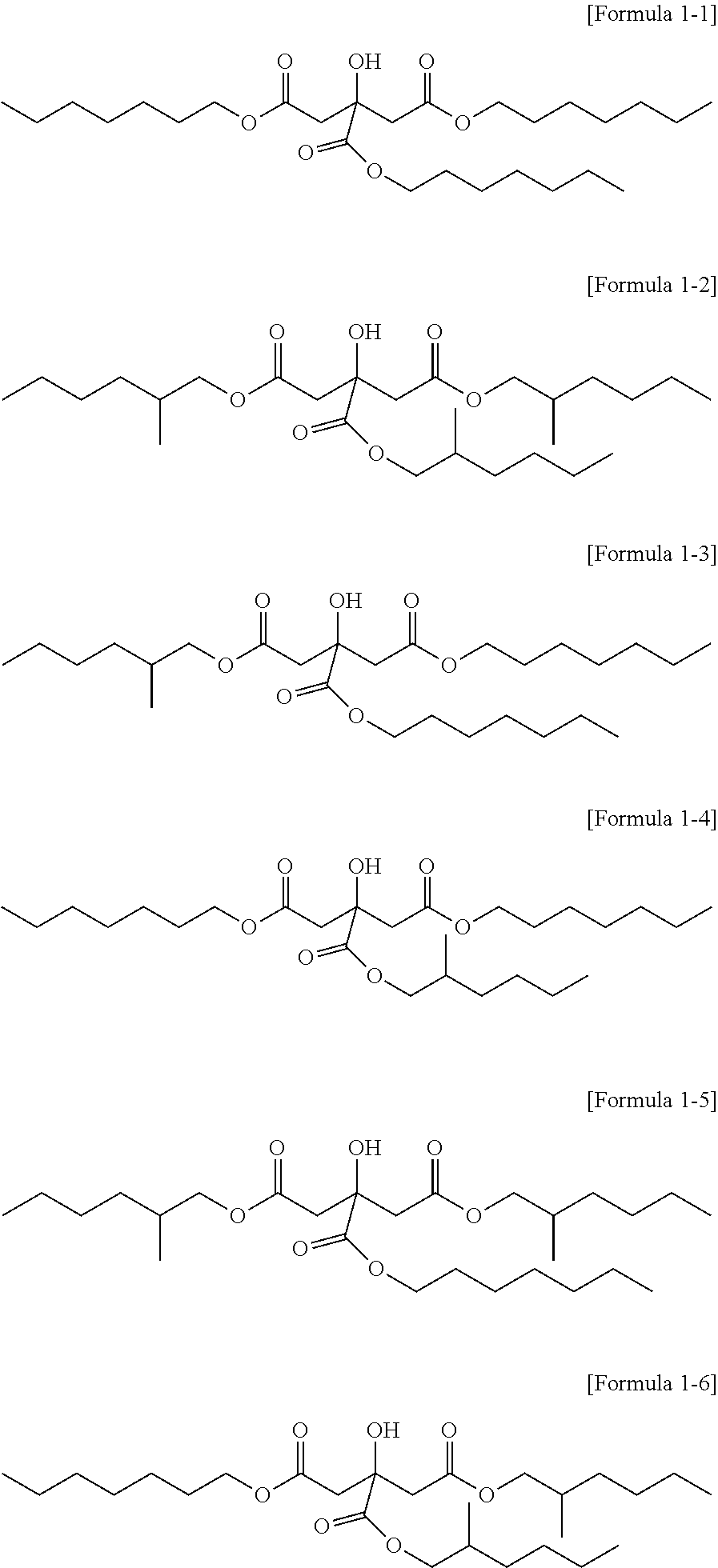Citrate-based plasticizer and resin composition including the same
a technology applied in the field of citrate-based plasticizers and resin compositions, can solve the problems of inability to improve the physical properties of products in view of processability with a resin, inability to achieve the effect of improving the physical properties of products, and reducing the cost of production, etc., to achieve the effect of excellent plasticizing efficiency, good enzymatic stability and good enzymatic stability
- Summary
- Abstract
- Description
- Claims
- Application Information
AI Technical Summary
Benefits of technology
Problems solved by technology
Method used
Image
Examples
preparation example 1
heptyl) citrate (THC)
[0066]To a four-neck, 3 liter reactor equipped with a cooler, a water stripper, a condenser, a decanter, a reflux pump, a temperature controller, and a stirrer, 576 g of separated 2-hydroxypropane-1,2,3-tricarboxlic acid (citric acid), 1,566 g of n-heptyl alcohol (Aldrich) (molar ratio 1:4.5) and 1.44 g (0.25 parts by weight based on 100 parts by weight of citric acid) of a titanium-based catalyst (TnBT, tetra-n-butyl titanate) as a catalyst were injected, followed by slowly elevating the temperature to about 170° C. Around 170° C., water generation was initiated, and esterification reaction was performed for about 4.5 hours while continuously injecting nitrogen gas under the reaction temperature of about 220° C. and an atmospheric pressure. The reaction was finished when an acid value reached 0.1.
[0067]After finishing the reaction, distillation extraction was performed for 0.5 to 4 hours under a reduced pressure to remove unreacted raw materials, the reaction p...
preparation example 2
methylhexyl) citrate (TiHC)
[0068]The same reaction method as Preparation Example 1 was performed except for using 2-methylhexyl alcohol instead of n-heptyl alcohol in Preparation Example 1 to finally obtain 1,435 g (yield: 98%) of tri(2-methylhexyl) citrate (TiHC).
preparation example 3
e Mixture (THC-1) of n-heptyl and 2-methylhexyl
[0069]The same reaction method as Preparation Example 1 was performed except for using n-heptyl alcohol and 2-methylhexyl alcohol at a ratio of 5:5 instead of n-heptyl alcohol of Preparation Example 1. In this case, the citrate mixture was a mixture of 26.5 mol % of the citrate represented by Formula 1-1, 48.5 mol % of the citrates represented by Formulae 1-3 and 1-4, and 25.0 mol % of the citrates represented by Formulae 1-2, 1-5 and 1-6.
PUM
| Property | Measurement | Unit |
|---|---|---|
| mol % | aaaaa | aaaaa |
| temperature | aaaaa | aaaaa |
| temperature | aaaaa | aaaaa |
Abstract
Description
Claims
Application Information
 Login to View More
Login to View More - R&D
- Intellectual Property
- Life Sciences
- Materials
- Tech Scout
- Unparalleled Data Quality
- Higher Quality Content
- 60% Fewer Hallucinations
Browse by: Latest US Patents, China's latest patents, Technical Efficacy Thesaurus, Application Domain, Technology Topic, Popular Technical Reports.
© 2025 PatSnap. All rights reserved.Legal|Privacy policy|Modern Slavery Act Transparency Statement|Sitemap|About US| Contact US: help@patsnap.com



